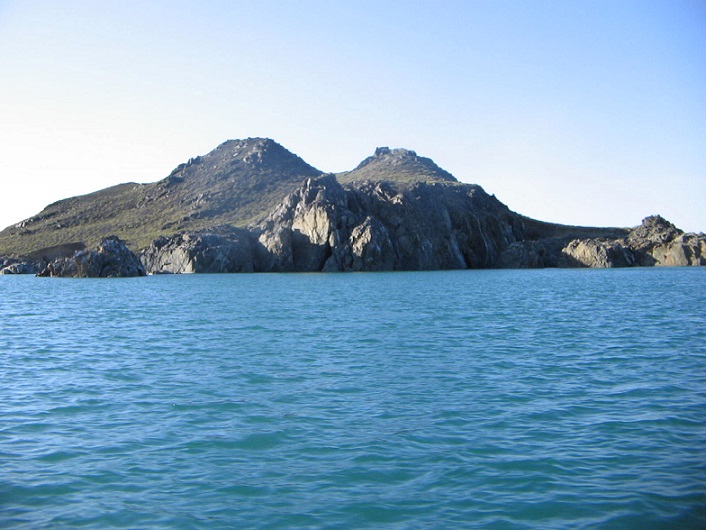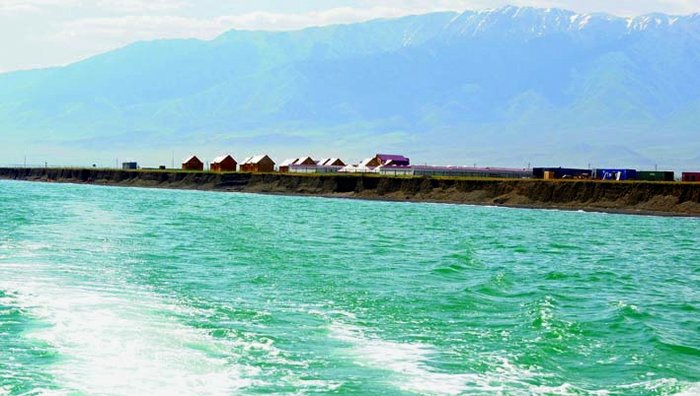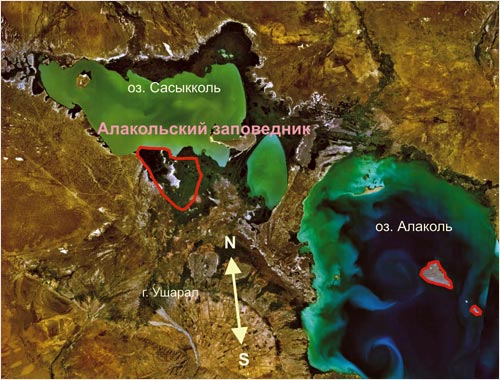Alakol State Nature Reserve

The Alakol State Nature Reserve is located on the territory of Urdzhar district of East Kazakhstan and Alakol district of Almaty oblasts of Kazakhstan. Its total area is 28.423 thousand hectares.The reserve was organized on April 05, 1998. It includes the wetlands of Alakol lakes, islands of Shubartubek and Araltobe, and Sasykkol water area.
Climate, relief and general information of the Alakol State Nature Reserve.
Of particular interest are ornithological tours that allow you to see with your own eyes endangered and rare mountain, desert and waterfowl, such as stiff-tailed duck, European and Dalmatian pelicans, bustard, Mac-Queen’s bustard, relict seagull.
The territory of the Alakol Reserve is dominated by a extremely continental climate with little snow in winter and dry summer. Three main types of air masses change here throughout the year: tropical, polar, and Arctic. The height of the snow cover on protected lands on average reaches 15 cm, in snowy winters this value increases to 100-130 cm.
Alakol Lake is located on the territory of the reserve at an altitude of 347 meters above sea level. Its composition is very close to the sea, because it contains sodium sulfate-chloride. Shores of the lake are a collection of black medicinal pebbles.
Flora and fauna of the Alakol State Nature Reserve
The local flora is represented by 270 species of plants, including: Berberis heteropoda, boat-shaped Scullcap, Rindera ochroleuca, ornithorynchous astragalus, spurge, Melica transsilvanica, common horsetail, white water lily, feather geranium, European hop, multiramose tamarisk, water milfoil, duckweed, hornweed, sedge, silverbubble matai, flowering rush, Bolboschoenus, common bulrush, narrow leaved reedmace, south reed grass and others.
The fauna of the Alakol Reserve includes 63 species of mammals, 269 species of birds, 22 species of fish, 24 species of reptiles, 2 species of amphibians and about 1000 species of insects.
The local avifauna is diverse and rich, represented by 118 breeding and 148 flying species. The most common are Lapland bunting, gray-necked bunting, yellowhammer, rock bunting), desert finch, trushes, finch, brambling, thistle-finch, linnet, scarlet grosbeak, desert finch, magpie, warbler, chiff-chaff, desert chat, redstart, pale harrier, imperial eagle, spotted eagle, duck hawk and others.
Rare and protected species include eagle owl, relict gull, great black-headed gull, little bustard, houbara bustard, bustard, demoiselle, common crane, short-toed eagle, white-tailed eagle, stiff-tailed duck, whooper swan, black stork, Dalmatian pelican.
Typical representatives of mammals are rodents, such as hamster, jerboa, dormouse, ground squirrel. In addition, in the protected area you can see wild boar, fox, roe deer, wolf, mink, otter, badger, ermine, weasel.
In local reservoirs there are white seabass, sazan, river and lake marinka, plain gubach, common minnow, sawbelly, Abbottina rivularis, stone moroco, golden carp, bream, scaleless osman, Balkhash marinka and others.
Climate, relief and general information of the Alakol State Nature Reserve.
Of particular interest are ornithological tours that allow you to see with your own eyes endangered and rare mountain, desert and waterfowl, such as stiff-tailed duck, European and Dalmatian pelicans, bustard, Mac-Queen’s bustard, relict seagull.
The territory of the Alakol Reserve is dominated by a extremely continental climate with little snow in winter and dry summer. Three main types of air masses change here throughout the year: tropical, polar, and Arctic. The height of the snow cover on protected lands on average reaches 15 cm, in snowy winters this value increases to 100-130 cm.
Alakol Lake is located on the territory of the reserve at an altitude of 347 meters above sea level. Its composition is very close to the sea, because it contains sodium sulfate-chloride. Shores of the lake are a collection of black medicinal pebbles.
Flora and fauna of the Alakol State Nature Reserve
The local flora is represented by 270 species of plants, including: Berberis heteropoda, boat-shaped Scullcap, Rindera ochroleuca, ornithorynchous astragalus, spurge, Melica transsilvanica, common horsetail, white water lily, feather geranium, European hop, multiramose tamarisk, water milfoil, duckweed, hornweed, sedge, silverbubble matai, flowering rush, Bolboschoenus, common bulrush, narrow leaved reedmace, south reed grass and others.
The fauna of the Alakol Reserve includes 63 species of mammals, 269 species of birds, 22 species of fish, 24 species of reptiles, 2 species of amphibians and about 1000 species of insects.
The local avifauna is diverse and rich, represented by 118 breeding and 148 flying species. The most common are Lapland bunting, gray-necked bunting, yellowhammer, rock bunting), desert finch, trushes, finch, brambling, thistle-finch, linnet, scarlet grosbeak, desert finch, magpie, warbler, chiff-chaff, desert chat, redstart, pale harrier, imperial eagle, spotted eagle, duck hawk and others.
Rare and protected species include eagle owl, relict gull, great black-headed gull, little bustard, houbara bustard, bustard, demoiselle, common crane, short-toed eagle, white-tailed eagle, stiff-tailed duck, whooper swan, black stork, Dalmatian pelican.
Typical representatives of mammals are rodents, such as hamster, jerboa, dormouse, ground squirrel. In addition, in the protected area you can see wild boar, fox, roe deer, wolf, mink, otter, badger, ermine, weasel.
In local reservoirs there are white seabass, sazan, river and lake marinka, plain gubach, common minnow, sawbelly, Abbottina rivularis, stone moroco, golden carp, bream, scaleless osman, Balkhash marinka and others.
Photo gallery
Contacts
General questions
Expedition, events
Interaction with Media
Legal information
ACCESSION QUESTIONARY
Individual
Status (on the procedure of accession to members and membership in the RPA in PDF format)
Legal entity
Status (on the procedure of accession to members and membership in the RPA in PDF format)

Спасибо!
Ваша заявка успешно отправлена
Мы свяжемся с вами в ближайшее время
Submit a work to the “My Kazakhstan” contest

Спасибо!
Ваше фото успешно отправлено
Ожидайте выбора победителей!

Спасибо!
Ваш заказ успешно отправлен
Мы свяжемся с вами в ближайшее время




